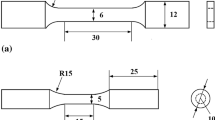Abstract
Porosity is well known to be a potent initiator of fatigue cracks in cast aluminum alloys. This article addresses the observed scatter in fatigue life of a cast A356-T6 aluminum-silicon alloy due to the presence of porosity. Specimens containing a controlled amount of porosity were prepared by employing a wedge-shaped casting mold and adjusting the degassing process during casting. High-cycle fatigue tests were conducted under fixed stress conditions on a series of specimens with controlled microstructures (especially, the secondary dendrite-arm spacing), and the degree of scatter in the results was assessed. Stochastically, such scatter was found to be adequately characterized by a three-parameter Weibull distribution function. Large pores at or close to the specimen surface were found to be responsible for crack initiation in all fatigue-test specimens, and the resultant fatigue life was related to the initiating pore size through a relationship based on the rate of small-fatigue-crack propagation. With respect to the probabilities for the pores of various sizes and locations to initiate a fatigue crack, a statistical model was developed to establish the relationship between the porosity population and the resultant scatter in fatigue life. The modeling predictions are in agreement with the experimental results. Moreover, Monte-Carlo simulation based on this model demonstrated that the average pore size, pore density, and standard deviation of the pore sizes, together with the specimen size and geometry, are all of consequence regarding scatter in fatigue life.
Similar content being viewed by others
References
I.J. Polmear: Light Alloys—Metallurgy of the Light Metals, 2nd ed., Edward Arnold, London, 1989.
S. Shivkumar, L. Wang, and C. Keller: AFS Trans., 1995, vol. 103, pp. 705–09.
Q.G. Wang, D. Apelian, and D.A. Lados: J. Light Met., 2001, vol. 1, pp. 73–84.
C. Nyahumwa, N.R. Green, and J. Campbell: Metall. Mater. Trans. A, 2001, vol. 32A, pp. 349–58.
M.J. Couper, A.E. Nesson and J.R. Griffiths: Fatigue Fract. Eng. Mater. Struct., 1990, vol. 13, pp. 213–27.
B. Skallerud, T. Iveland, and G. Harkegard: Eng. Fract. Mech., 1993, vol. 44, pp. 857–74.
J.-Y. Buffiere, S. Savelli, P.H. Jouneau, E. Maire and R. Fougeres: Mater. Sci. Eng., 2001, vol. A316, pp. 115–26.
M.J. Caton, J.W. Jones, and J.E. Allison: Fatigue Crack Growth Thresholds, Endurance Limits, and Design, ASTM STP 1732, J.C.J. Newman and R.S. Piascik, ASTM, Wext Conshohocken, PA, 2000, pp. 285–303.
J.M. Boileau: Ph.D Thesis, Wayne State University, Detroit, MI, 2000.
J.C. Ting, V. Frederick, and F.V. Lawrence: Fatigue Fract. Eng. Mater. Struct., 1993, vol. 16, pp. 631–47.
S. Savelli, J.-Y. Buffiere, and R. Fougeres: Mater. Sci. Forum, 2000, vols. 331–337, pp. 197–202.
K. Shiozawa, Y. Tohda, and S.-M. Sun: Fatigue Fract. Eng. Mater. Struct., 1997, vol. 20, pp. 237–47.
Q.G. Wang, D. Apelian, and D.A. Lados: J. Light Met., 2001, vol. 1, pp. 85–97.
P.J. Laz and B.M. Hillberry: Int. J. Fatigue, 1998, vol. 20, pp. 263–70.
W. Mendenhall and T. Sincich: Statistics for Engineering and the Sciences, 4th ed., Prentice-Hall, Englewood Cliffs, NJ, 2000, pp. 111–60.
E.E. Underwood: Quantitative Stereology, Addison-Wesley, London, 1970, pp. 109–45.
K.J. Kurzydlowski and B. Ralph: The Quantitative Description of the Microstructure of Materials, CRC Press Inc., London, 1995, pp. 83–85.
R.L. Fullman: Trans. AIME, 1953, vol. 197, pp. 447–52.
J.E. Spowart, B. Maruyama, and D.B. Miracle: Mater. Sci. Eng., 2001, vol. A307, pp. 51–66.
M.H. El Haddad, T.H. Topper, and K.N. Smith: Eng. Fract. Mech., 1979, vol. 11, pp. 573–84.
R.W. Hertzberg: Deformation and Fracture Mechanics of Engineering Materials, 4th ed., John Wiley & Sons, New York, NY, 1996, pp. 622.
K. Gall, M.F. Horstemeyer, B.W. Degner, D. McDowell, and J.H. Fan: Int. J. Fract., 2001, vol. 108, pp. 207–33.
Y. Murakami: Eng. Fract. Mech., 1985, vol. 22, pp. 101–14.
A.D. Bussac and J.C. Lautridou: Fatigue Fract. Eng. Mater. Struct., 1993, vol. 16, pp. 861–74.
M.T. Todinov: Mater. Sci. Eng., 1998, vol. A255, pp. 117–23.
A.P. Bazant: J. Eng. Mech., 1984, vol. 110, pp. 518–35.
M. Makkonen: Int. J. Fatigue, 2001, vol. 23, pp. 395–402.
Author information
Authors and Affiliations
Rights and permissions
About this article
Cite this article
Yi, J.Z., Gao, Y.X., Lee, P.D. et al. Scatter in fatigue life due to effects of porosity in cast A356-T6 aluminum-silicon alloys. Metall Mater Trans A 34, 1879–1890 (2003). https://doi.org/10.1007/s11661-003-0153-6
Received:
Issue Date:
DOI: https://doi.org/10.1007/s11661-003-0153-6




